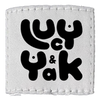As a knitter I'm a big wool fan. It's amazing stuff. It repels water, keeps you warm in winter and cool in summer (to some extent) and it's soft and fluffy. What's not to love? For those who are vegan it's not the right option but there are good examples of sheep farming that claim to be cruelty free and sustainable so for non-vegans it's definitely a material to consider.
The animals involved in wool
Right at the outset of this post I want to talk about something that consumers should know about. I didn't know about it until I started looking into this topic so it's another of those things that's under the surface. It's called mulesing. It involves cutting part of the sheep's skin away to discourage flystrike. Often without anaesthetic it can be pretty brutal.
This practice has been phased out in New Zealand but is common in Australia where animal rights records for sheep are not great. Something else to look out for when looking to buy. It really is about being informed about what you are buying and where it is coming from. Again, it's important to look out for organic. To be certified as organic, farmers have to treat the environment, the animals and the producers with care.
Sheep are so great, aren't they?! Such appealing animals with their big eyes. And the way the lambs wag their tails when they are feeding! Turns out they are also a great carbon store, which is environmentally important. 50% of the weight of the fleece is carbon. That's pretty amazing! They are also good for the land, as grazing sheep improve the soil quality and in doing so also increase the water retention of the soil.
The process of making wool
Fabric doesn't grow on trees so there is always going to be processing. And there is pretty much always a quick, environmentally costly method, and other methods that have a lower impact but often involve more work. I guess it's a choice about how the cost is paid; do we let the earth pay the price or are we willing to dig a little deeper into our monetary resource? Our money is a resource too and one worth investing, rather than taking from the natural resources our planet offers. They might seem free, but they are not.
The first step from fleece to fabric (once you've done the shearing!) is scouring. Even well cared for sheep produce fleeces that need a really good wash. This can be done using aggressive chemicals, but it doesn't have to be. It does involve a lot of water though. This is less of a problem if nasty chemicals are not added to the water, but it's still something to think about. After that there's the spinning and either weaving or knitting (using on a machine) that typically takes place in factories. That's not necessarily a bad thing, depending on how the factories are run.
In the UK wool has been one of the biggest industries for centuries. In fact, the cultivation of cotton was banned here to protect the wool industry. Sourcing wool locally also makes a big difference to the environmental impact of the fabrics we buy.
Finally, wool is hard wearing and robust. It is the kind of fabric you can keep on wearing for years. The process and production of the fabric is really important. Even more important is to keep wearing and not just throw away. As a knitter, I think really carefully about what I'm going to make. After hours of knitting, I don't want to wear it a few times and then chuck it. Also, it's going to take a long time to make so it's important to choose the right pattern. I don't take the same care when buying something. After all, a click on the “Buy now” link takes just a moment. The materials are essentially the same though so I ought to take the same care. Next time I'm making a purchase I'm going to try asking myself those kinds of questions. Would I have taken the time to make this myself? If I wouldn't bother, do I really need to buy it?
Recycled wool
This leads me onto recycled wool. It is amazing, but we wanted to keep our clothing Vegan. We use no animal products in any of our designs, but this winter we really felt we had to create a coat, and wool is the best, for all of the reasons stated above. However we wanted to use wool that already existed as a garment and had come to the end of its life.
Recycling wool is a pretty easy process, the results are also beautiful, they give the garment a unique look and texture that is just stunning!
Meet 'Austen' our gorgeous coat made from Recycled wool

Recycled wool is reclaimed from textile waste and unwanted or discarded garments. The mill is able to mix already-dyed fibres to create colour, rather than shearing new wool and treating and dyeing the fibres. The mill will sort old garments into similar colours and spin a new fabric using these, this means that each new garment has character, with small speckles of different shades of colour, creating a product with character.
As always if you have any feedback please let us know, we try to find information that is as accurate as possible, but if you think we missed something or misrepresented anything please let us know.

